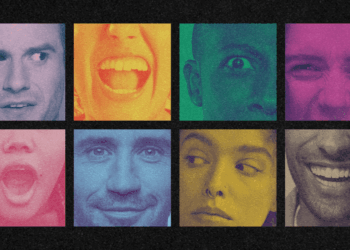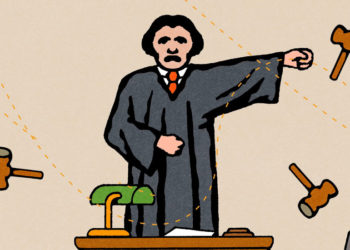A half-century ago, ABC’s “Barney Miller,” a sitcom about seen-it-all cops and kitchen-sink criminals at a precinct in Manhattan’s West Village, aired an episode that began like any other.
Detective Ron Harris (Ron Glass) got a call about a man threatening to jump off the Washington Arch. The payroll department thought Detective Phil Fish (Abe Vigoda) was dead. Capt. Barney Miller (Hal Linden) kept everybody in check.
Then a quippy gay couple named Marty and Darryl, played by the actors Jack DeLeon and Ray Stewart, swished in and made history as one of the first openly gay couples in mainstream American television.
Yet 50 years after it aired, “Discovery,” as the second-season episode was called, is largely forgotten for its important place in the record of queer representation on TV.
Stewart thinks a neat gift for his 94th birthday next year would be to get some overdue credit for being years ahead on “the homosexual thing,” as he put it.
“I didn’t realize how innovative“ the episode was, he said over the phone from home in his native San Benito, Texas. “We really were the Wright Brothers in a sense.”
“Discovery,” which debuted on Oct. 30, 1975, was a notable coming out. For many TV viewers, Marty and Darryl may have been the first openly gay couple, fictional or otherwise, that they had ever seen or heard. (Marty introduces Darryl as “his friend,” but come on.)
It was Marty’s third appearance on the show — he was in eight episodes overall — and he and Darryl also appeared together in several later episodes, including in the series finale. This made Marty one of American television’s first recurring gay characters and the two of them one of TV’s first recurring same-sex couples. The show also featured a gay cop character.
Gay characters had appeared on television before. Many were villains, like the killer lesbians in the 1974 “Flowers of Evil” episode of “Police Woman.” Others were treated more sympathetically. In a 1971 episode of “All in the Family,” the curmudgeonly Archie Bunker (Carroll O’Connor) learns that his strapping bachelor friend Steve (Philip Carey) is gay, a model for future coming out episodes. In 1973, Lois Nettleton played a (happy! smiling!) lesbian psychiatrist in the CBS drama “Medical Center.”
There were gay characters in “The Corner Bar” (1972-73) and “Hot L. Baltimore” (1975), but those shows were flops. “Barney Miller” was not: It ran eight seasons and won three Emmys. (You can stream it on Tubi.)
“Discovery” also stands out for why Marty and Darryl went to the cops in the first place: to report that Darryl had been shaken down by a man impersonating a police officer, a so-called “fruit hustle,” to borrow a phrase from the queer television historian Matt Baume.
It was no fiction: At the time the episode aired, queer people were often targets of extortion and other forms of violence in the West Village, home of the Stonewall Inn and a center of New York gay life and activism.
That Marty and Darryl were taken seriously by the police — at least make-believe TV cops whom Marty calls his “friends” — was a testament to the efforts of Danny Arnold, the former Marine who created “Barney Miller.” He tried to make the show a social mirror and a corrective, akin to what Norman Lear did in his hit sitcoms “All in the Family” and “The Jeffersons.”
Steven Capsuto, the author of the book “Alternate Channels: Queer Images on 20th-Century TV,” said that by the second season, the writers of “Discovery” — Arnold, Tom Reeder and Chris Hayward — were used to being nagged by ABC censors over content related to sex and sexuality, especially during the so-called Family Hour, a period between 7 and 9 p.m.
“The networks considered any acknowledgment that gay people existed as talking about sex,” Capsuto said. “Even using the word gay made the networks nervous.”
Was the studio audience laughing at Marty and Darryl rather than with them? Sure: Gays lived in the shadows, sodomy laws were on the books, and these two particular queens were flamboyantly costumed in a baby blue leisure suit jacket (Marty) and a cranberry ombré cardigan (Darryl). According to Arnold, network executives also worried early on that the swishy Marty might offend gay viewers, Capsuto writes; many of those viewers were already miffed about other series that had treated homosexuality as a sickness, including the drama “Marcus Welby, M.D.”
But Arnold wasn’t one to back down from controversial topics (and the raucous applause received by the characters as they walked on set suggested that the studio audience, at least, was a relatively open-minded one). In Geoffrey Cowan’s 1980 book “See No Evil: The Backstage Battle Over Sex and Violence on Television,” Arnold is quoted as saying in a 1975 news conference that it would be “a tremendous disservice” to young people if “we keep telling them that life is ‘The Brady Bunch.’”
“It’s really our job to tell them that life has to do with issues, has to do with problems, has to do with sex, has to do with a lot of things that they’re going to come into contact with when they get out into the world,” he continued.
For Stewart, Darryl was a mixed blessing. (DeLeon died in 2006.) Playing Darryl led to more work after “Barney Miller” went off the air in 1982, including on “Dallas” and “Days of Our Lives.”
“I dreamed of being an actor and I did it,” he said. “I have no regrets about that. I never became a star. But I became good at it.”
Yet he found himself being typecast.
“You once play a jeweler, casting directors say, ‘Oh a jeweler, that’s Ray,’” he said.
He left television in the early 1990s. These days, Stewart acts in and directs shows in nearby Brownsville, Texas, and South Padre Island, a return to his stage roots on Broadway.
Although he played a pioneering gay character, Stewart kept his sexuality private. He said he never felt the need for a partner or to come out. That has changed.
“In my old age, I’ve realized that I’m basically gay,” he said.
In Darryl and “Barney Miller,” he found not just a paycheck but a purpose.
“It’s one of my proudest moments,” he said.
The post How the Cop Show ‘Barney Miller’ Made Gay TV History, 50 Years Ago appeared first on New York Times.




